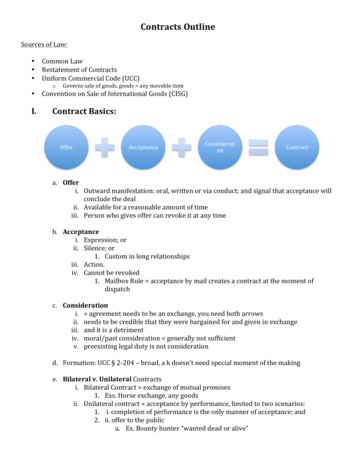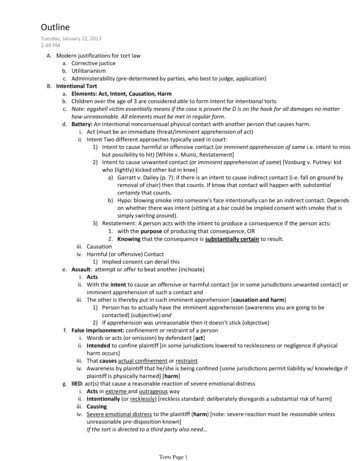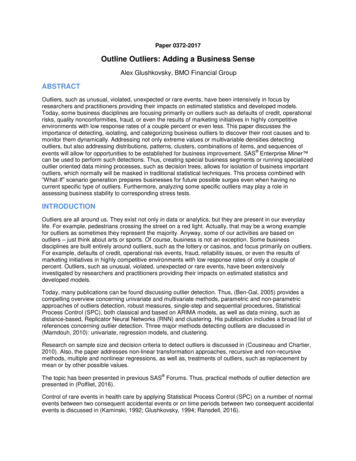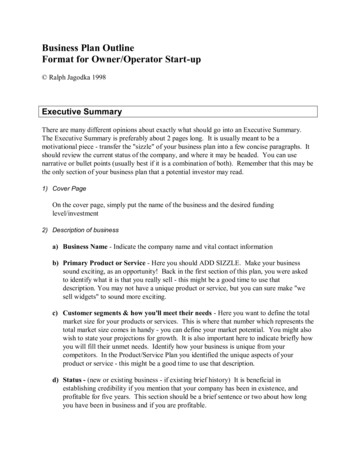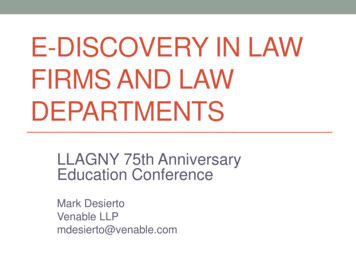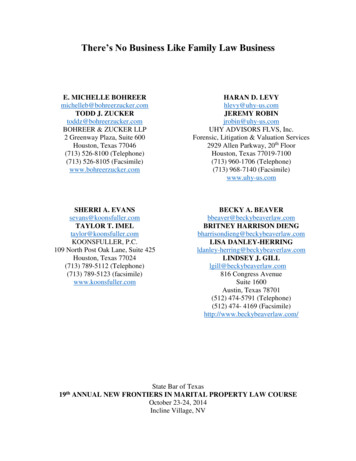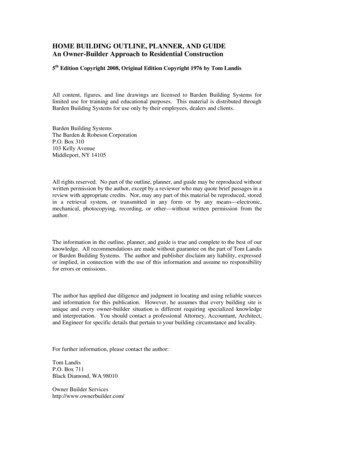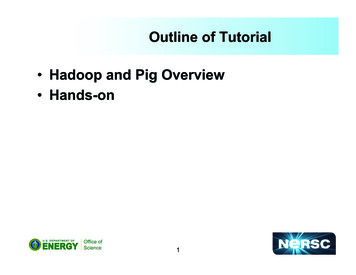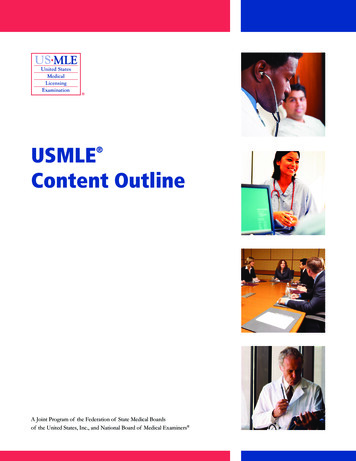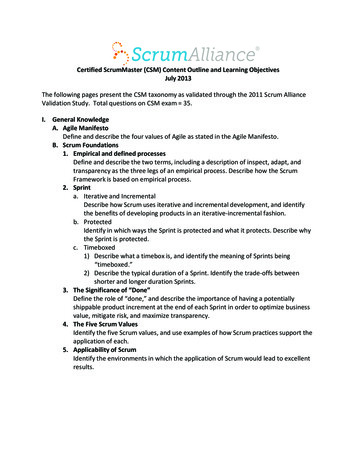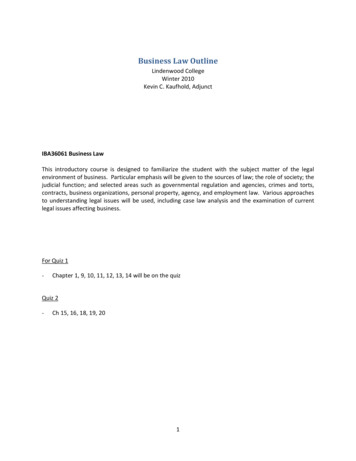
Transcription
Business Law OutlineLindenwood CollegeWinter 2010Kevin C. Kaufhold, AdjunctIBA36061 Business LawThis introductory course is designed to familiarize the student with the subject matter of the legalenvironment of business. Particular emphasis will be given to the sources of law; the role of society; thejudicial function; and selected areas such as governmental regulation and agencies, crimes and torts,contracts, business organizations, personal property, agency, and employment law. Various approachesto understanding legal issues will be used, including case law analysis and the examination of currentlegal issues affecting business.For Quiz 1-Chapter 1, 9, 10, 11, 12, 13, 14 will be on the quizQuiz 2-Ch 15, 16, 18, 19, 201
Chapter 1 – Legal HeritageQuote – ‐John Locke ‐‐‐ “Where there is no law, there is no freedom”What is Law?Definitions‐ Law consists of rules regulating the conduct of individuals, business, and other organizations in asociety.‐ Intended to protect persons and property against unwanted interferences from others.‐ Must be obeyed and followed by people subject to legal sanctions.‐ Body of rules issued by a controlling authority to be obeyed and followed.Function of law‐ Keep the peace‐ Shape moral stds‐ Promote social justice‐ Maintain status quo‐ Facilitate orderly change‐ Facilitate planning‐ Provide a basis for compromise‐ Maxi individual freedomsFairness of the Law‐ The US legal system is one of the most comprehensive, fair, and democratic systems everdeveloped.‐ But, oversights exist ‐‐‐ mistakes of law or of fact; abuse of discretion;Flexibility of the Law‐ US law evolves and changes with the norms of society, technology, and expansion of commerce‐ “largely vague and variable”‐ General set of principles and rules to guide us‐ New problems encountered needs a system that is flexible and fluid‐ Brown vs Bd of Ed (US 1954), at 5 ‐‐‐ 9‐0 decisiono Equal protection clause was to guarantee equality (14th Amendment, 1968; post civil war A)o Plessy vs Freguson (US 1896) – separate but equal accommodations for African American(then known as Negros, or blacks) on railways was permissible under 14th Ao Brown holding: Separate but equal has no place in the field of public educationo Separate educational facilities are inherently unequal.2
Schools of JurisprudenceNatural law school – a moral theory of law based on morality and ethics (locke; Hume)‐ US Constitution, Magna Carta, UN Charter influenced by this belief‐ But whose morality?Historical School‐ Aggregate of social conditions, traditions, customs developed over the centuries‐ Changing norms of society will be eventually reflected in the law‐ Evolutionary processAnalytical – law is shaped by logic (Aristotle; some philosophers)Sociological – law is means of achieving certain goals or desires of societyCommand – law is a set of rules by the ruling parties (Marxism)Critical studies – subjective decisions would be permitted without the use of legal rules‐ But again, with whose morality? And to who’s favor?Law and Economics – This is the Chicago school‐ Market efficiency should be the centerpiece of legal decision making‐ But market efficiency can be elusive at best, more theoretical than practical(NOT INCLUDED in text, but very important) Conflict resolution modelHistory of American LawEnglish common law‐ Common law is judge made law‐ Can be done without laws being enacted (critical legal studies school)‐ Prior rulings become precedents in future cases‐Law courtso Local laws replaced after 1066 by a uniform set of laws (William the Conqueror)o Law courts administered this lawo Emphasis on form of law (legal prudence) rather than the merits of a caseo Monetary damages only; could be unfair in result, but correct in precedent‐Chancery Courts (exchequer courts, or kings court)o Law courts had a limited remedy (money)o Goal is to do equity, to do fairnesso Equitable remedies‐Merchant courtso The law merchant was based on common trade practices and customs3
ooAbsorbed into law courts by early 1900’s in UKMuch of UCC and commercial law in US is partly based on merchant court heritage‐Common law adopted in US, 49 stateso Louisiana follows the Napoleonic Code and French lawo Several SW states also have a Spanish law influence (marital prop rules are different, etc).o Another system internationally is Romeo Germanic civil law system dating to 450 bc. Civil code and parliamentary statutes are sole source of law Litigation involves the adjudication of a code or statute‐US law has many trappings of English common law,o but is also civil code based (US laws and Const),o so amounts to a mixing of all prior legal systems, with common law providing lots ofhistorical development pointsSources of US LawConstitution of the US‐ Supreme law of the land ‐‐‐ all other state or local laws in conflict are unconstitutional‐ Broad principles;‐ Living, breathing document‐ Separate branches of national govt‐ Non‐enumerated powers are reserved to the states and to the peopleTreaties‐ A compact with other nations‐ Upon ratification by both sides, may supersede even the ConstitutionStatutes‐ Written documents passed by legisl.‐ Fedl or state legislatures; even municipalities (ordinances)‐ Codified laws designed to implement different activities of govt and societyExecutive orders‐ US presidential power‐ May be as important as laws‐ Example: during war, President may prohibit companies to engage in certain types of business withforeign business, govtsRegulations‐ Administrative agencies‐ Rules and regulations implementing laws within an agencies area (Dept of Commerce)Judicial Decisions‐ Stare decisis – past decisions become precedential, and then followedo Adherence to past precedent is called stare decisis4
oProvides stability of law (predictability)Priority of Laws‐ Treaties; US Constitution; Federal law; federal regulations‐ State const; state laws;‐ muni ordCase 1.1‐ prohibition on women working more than 10 hours per day‐ Illinois Supreme Court upheld the statute‐ Noting the burdens of motherhood‐ Rearing of children & maternal function‐ Maintenance of homeunfairness in current light; certainly not lawful today‐ equal protection clause; title VIIIFor its time, fair in that‐ protective in nature;‐ women had special needsoverall, example of social justice and flexibility in the law‐ should be noted that matter is handled today in terms of overtime (not available in 1909); OSHAregs; sex based discrimination (title VII) and DIB accommodation (pregnancy).‐ Still a notion of protection in the law; we broaden the scope todayCase 1.2- draft ended in 1975; Carter wanted to reactivate the draft in 1980 for both sexes; Congressappropriated funds only for men; Several men brought suit.‐ US Supreme court upheld the law‐ Not a case of arbitrarily choosing between two similarly situated groups‐ Congress was proper party to articulate a public policy‐ Marshal dissent: women are excluded from a fundamental civil obligationDiscussion—likely that congress harbored the notion that women should simply not fight in combat‐ Not only is the Marshall dissent on point being a fundamental civil obligation,o But systematic exclusion of women prevents them from advancing in military positions(which would be a civil right with benefits, ranks, etc)o Contrast to Israeli position on women in combat‐‐Case might have turned differently had women been the plaintiff making such argumentso Underlying tone of the case simply seen as men attacking the draft, using sex‐based issuesto exert political policyAnother example of social justice & changing aspects to the law5
Chapter 9 – Nature of ContractsQuote ‐The movement of progressive societies has hitherto been a movement form status to contract Sir Henry MaineIntroduction ‐‐‐Two or more parties VOLUNTARILY enter into an agreementPrivate obligations between the partiesLegally enforceable agreementDefinition of a contract ‐‐‐‐Restatement of contracts, 2d ‐‐‐ K is a promise or set of promises for the breach of which the lawgives a remedy or the performance of which the law in some way recognizes a dutyParties to a contract – offeror makes an offer; offeree power to accepto This is traditional notion; today, both parties are commonly seen as making one or moreoffers, bi‐laterally, especially in more complex dealings; more common to just say party 1,party 2 (can be three, four etc).Elements:o Analytical processo Offero Acceptanceo Consideration – bargained for consideration Usually an exchange of money ( 1 and other valuable consideration) Could simply be a promise for a promise that has been relied upono Contractual capacity (affirm defense?)o Lawful object (affirm defense?Defenseso Consent must be genuine (weak defense, actually)o Written form Only on certain matters Illinois recognizes oral contractsSources of Contract law‐‐‐Common lawUCC (Illinois has adopted)Restatement of contracts6
Objective theory of contracts‐Reasonable person standard –o intent to enter into a contract is judged by a reasonable person and not by subjective intentof partieso more of an issue of offer and acceptance;o and intent of the parties is still important as to the meaning and interpretation of thecontractClassification of contracts‐‐‐‐‐‐bilateral contracts ‐‐‐ promise for a promiseunilateral contract – acceptance is done by performance of an action, not a promiseo painting a shop by July 1, I will pay 3000incomplete or partial performanceo revocation before attempted performance? May be possible at common law Modern contracts typically specify a breach in such instancesFormal contractso Neg instruments (UCC)o Letters of credito Recognizanceo Contracts under sealInformal contracts may be oral or in writing and are still enforceableValid contracts meet all elementso Void contract has no legal effect (illegality)o Voidable is where one or both parties have the option to avoid te Ko Unenforceable K – some legal defense existso Executory K’s have not yet been fully performedExpress and Implied‐‐‐Express is in writing or oral, but which is expressly known by the partiesImplied‐in‐fact is where the conduct of the parties give evidence of a contractImplied‐in‐lawo Aka quasi contracto Monetary damages even where no contract existso Prevents unjust enrichment or unjust detrimento Example with hospital bill and coma patientEquity‐‐Judicial decisions made on fairness, natural law, etcEquity may save a contract p. 162 example7
Chapter 10 – AgreementQuote‐Where law ends, tyranny begins ‐‐ william pittOffer‐‐‐‐Willingness to enter into an agreementObjectively intend objective theory of a contract – judged by reasonable person standardBe reasonably certaino can have express or implied terms traditional vs modern case law implied term if it can reasonably be supplied by the courtCommunicated to the other partySpecial offers‐‐‐Advertisement is an invitation to make an offero Not an offer itselfo Protects the advertiser; Ads may still be evidence of intent !Rewardo Performance relatedo Offeree must have knowledge of the award and have completed the actAuctionso With reserve – seller reserves the right of refusal if offer is not sufficiento Without reserve – no right of withdrawal of offer at auctionTermination of offer by act‐‐‐Revocation of offer should be unequivocally madeo Problems as to whether the person revoked offer prior to acceptanceInitial offer can be rejectedo Expressly or impliedlyo Problems with impliedCounteroffero Terminates prior offer and proposes additional or revised termso Contra: labor law ‐‐‐ counter offer must be narrower or same level, and does NOT revokeprior offer, as offers must stand (good faith in labor law vs no good faith requirement in K)Termination of offer by law‐‐‐Destruction of subject matterDeath or incompetency of the partyo Prior to acceptanceIllegality superveningo 18% interest rates made illegal as usurious8
‐Lapse of timeo Either stated or implied by conducts of the partyAcceptance‐‐‐‐Unequivocal acceptanceo Mirror image ruleo Must accept same thing as offered; vs counter‐offerSilence may constitute acceptanceo Detrimental reliance issueso Prior dealings and practiceo Prevent this issue by putting time limits on offersTimes of acceptanceo Mailbox rule ‐‐‐ acceptance occurs when mailedo Alter this by specific terms of offerMode ‐‐‐o Expresso Implied ‐‐‐ is it customary for the industry involved?9
Chapter 11 – ConsiderationIntroduction‐‐Consideration 1) something of legal value in exchange for a promise AND 2) bargained forexchange“seals the deal”Gift Promise‐Gratuitous promises are unenforceable bc lacking considerationo No bargained for exchangeo Amounts to a giftContracts lacking Consideration‐‐‐‐‐‐Illegal consideration (burn your house down)o Drugs cannot be something of valueIllusory promiseo Either or both parties do not have to perform; they can if they wanto No obligation to performMoral obligationo Sense of honoro Minority of states: still amounts to CPre‐existing dutyo Something a person already is under an obligation to doPast considerationo A prior act will not support a new KBusiness contracts ?o Greater flexibility in consideration Bc of sophistication on parties and industry stdso Output K – agreement to sell ALL output (variable in nature)o Requirement K – all requirements for an itemo Best effort K – one or both parties use best efforts RE K to have broker use best efforts to find a buyerSettlement of claims‐‐Settlement of disputed K claims accordIf accord is performed, it is satisfaction10
Equity promissory estoppels‐‐Prom estoppel prevents withdrawal of promise if it will adversely affect a position of a party whoacted in reliance on the offerDetrimental reliance concept is used where there is no Consideration but where a person may haveacted on the original offerCase Assignment‐‐Case 10.3 – implied termsCase 11.1 – considerationCase 10.3 Implied terms ‐‐‐Edmonds vs. MacDonalds, 171
Business Law Outline Lindenwood College Winter 2010 Kevin C. Kaufhold, Adjunct IBA36061 Business Law This introductory course is designed to familiarize the student with the subject matter of the legal environment of business. Particular emphasis will be given to the sources of law; the role of society; theFile Size: 270KBPage Count: 36
